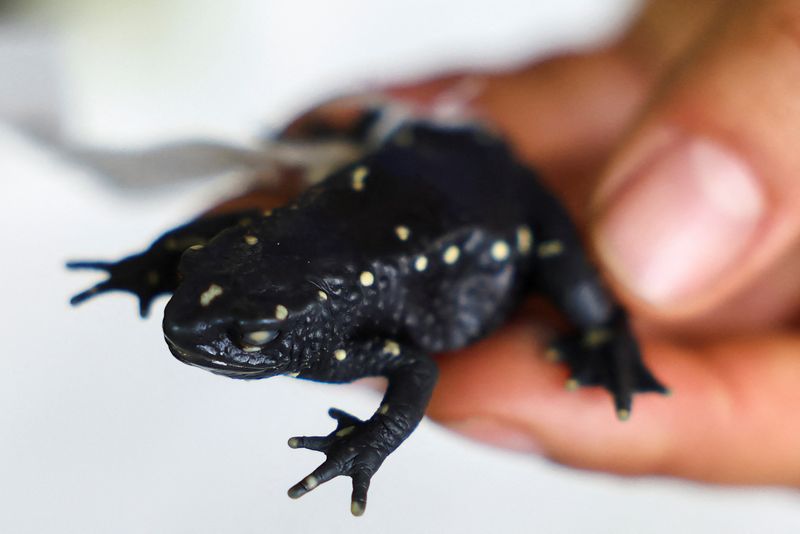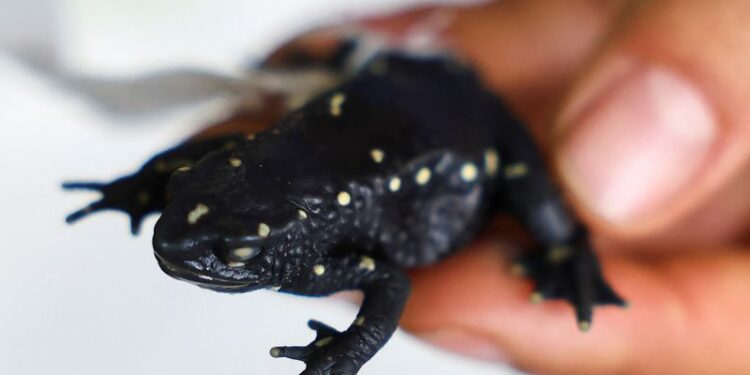By Jake Spring
(Reuters) – For more than five decades as violent conflict raged through Colombia’s highlands and rainforests, wildlife thrived.
From brilliantly colored orchids to tiger-striped frogs, scientists have uncovered a wealth of new animal and plant species in the years since a 2016 peace deal saw most rebels with the Revolutionary Armed Forces of Colombia (FARC) lay down their weapons. The accord made it safe to enter many parts of the country, often pristinely preserved amid the conflict.
Peace, it turned out, offered a boon for nature research. Scientists have found roughly triple the number of new plant species in Colombia each year since the peace accord as they did before the deal, according to a new analysis by Colombian botanist Oscar Alejandro Perez-Escobar shared exclusively with Reuters.
But the FARC deal did not end Colombia’s conflict. Though the accord opened many areas of Colombia up for science, other armed groups – including former FARC fighters who rejected the peace deal – and crime gangs filled the vacuum in some areas and brought renewed dangers for both researchers and wildlife.
Although deforestation fell to a 23-year low last year, it is on the rise again in 2024 as severe drought fed wildfires, and illegal logging, mining and roadbuilding destroyed the jungle. And for environmentalists, Colombia is now the world’s most dangerous place – with 79 killed last year, the most ever in one country in a single year, according to nonprofit Global Witness.
The analysis of some 14,000 Colombian plant species recorded at Royal Botanic Gardens Kew showed that researchers have published an average of 178 new finds in the years since the peace deal. That compares with 53 on average in the years before the accord.
The analysis, which has not been peer-reviewed, also accounted for the imbalance between the few years of data since 2016 as compared to centuries of prior species discovery.
While the analysis shows a jump in publications after the peace deal, it does not prove the accord was the cause, Perez-Escobar said.
He recalled his first expedition after the peace deal, traveling with a team of researchers from 16 countries through a mountainous ecosystem as Colombian soldiers guarded their moves in 2018.
“I was excited, but also nervous,” said Perez-Escobar, who works for Kew Gardens in Britain. “Excited of the prospects of finding new species … but also nervous because of the danger it represented going there.”
That expedition was part of a wave of biodiversity research in Colombia’s former rebel strongholds, which scientists had steered clear of for fear of kidnapping or death at the hands of the FARC. On the trek high above the treeline into the mountainous Paramo ecosystem, he spotted small yellow-and-brown flowers – a new species of orchid. A paramo is a very moist, cold and often foggy alpine grassland high up in the Andes.
Since then, Perez-Escobar working in partnership with local organizations has helped to identify two new flowering plants in a cloud forest and last year the first known polymorphic orchid in its genus of 1,200 species, meaning it blooms two different types of flowers on the same plant.
CROCODILES, DRONES & DEFORESTATION
As a biology student in the 1990s, botanist Mauricio Diazgranados would collect plants in the mountains an hour’s drive from Bogota.
“I could see the helicopters shooting at the guerrillas and the guerrillas fighting back,” said Diazgranados who now works as science director of the New York Botanical Garden.
At one point, he worked as a volunteer park ranger in the Sumapaz area where the FARC once kept its headquarters. He said he was once detained by rebels on suspicion of spying but managed to escape during the night and flee.
Diazgranados later helped to organize dozens of science expeditions into previously dangerous areas under Colombia BIO, a government program launched to better understand the country’s wilds after the peace deal. He still has cardboard boxes filled with dried plant samples that he thinks are new species but has yet to describe in publication.
While the conflict may have helped to shelter Colombia’s wildlife for decades, it is the country’s location and geography that helped it to flourish into what it is today.
Located near the warm band of the Equator where North and South America meet, the country includes beaches, tropical rainforests and three distinct chains of the Andes that soar from deep valleys to more than 5,000 meters (17,000 feet). The diversity of these environments has encouraged more species to evolve over time.
Colombia topped a list this year of countries thought to have the most undiscovered plant species, according to a study led by Kew Gardens scientists that was published in August.
It is not only the peace deal that is driving more discoveries, Diazgranados said. More trained scientists are researching Colombia than ever, he said, including some turning away from nearby Venezuela amid the economic and political crisis there.
Scientists at Colombia’s state-run Alexander von Humboldt Biological Resources Research Institute have found dozens of new species including beetles, frogs, a spider and a caecilian – a rare group of legless amphibians that live underground. It can take several years for a species find to be confirmed as new.
“They were inaccessible areas, but also areas with enormous information and natural wealth,” said Jhon Cesar Neita, who curates Humboldt’s entomology and invertebrate collection, about former FARC-held areas that opened up to research.
“All of us scientists wanted to go.”
Scientists with the Wildlife Conservation Society (WCS) have also recorded another 10 amphibian finds, including a green-brown striped rain frog to be named for Colombia’s peace deal: Pristimantis pactumpacis.
After the peace deal, WCS researchers were able to use drones to count eastern Colombia’s critically endangered Orinoco crocodiles in an area previously too dangerous, said the group’s Colombia director, German Forero.
But after more than 100 people were reported killed in violence related to armed groups in the area this year, Forero said, WCS staff currently cannot travel back to where the Orinoco crocodile lives.
LOSING GAINS
Colombia has put the security issue in focus at this year’s U.N. Biodiversity Conference, COP16, choosing the theme “Peace with Nature” for the event being held in the southwestern Colombian city of Cali. More than 10,000 soldiers, police and U.N. guards are mobilized to protect the summit, while delegates from nearly 200 countries discuss how best to preserve nature worldwide.
There is currently intense fighting between the armed groups in some of the most biodiverse parts of the country, according to sources within the Colombian military. In the Pacific province of Choco, home to verdant rainforest and famously wet weather, the ELN rebels are fighting the Clan del Golfo crime gang, while competing FARC dissident groups face off in several Amazon (NASDAQ:) provinces.
Along with continuing violence by armed groups, Colombia is now also at risk of rapid environmental decline, scientists warned. Deforestation has jumped 40% in the first three months of this year, according to government data.
Environment Minister Susana Muhamad in April blamed a group of former FARC fighters called the Estado Mayor Central for the forest clearing in the Amazon rainforest, saying it blocks outsiders from entering areas it controls while pressuring locals to cooperate.

“It’s miserable, the psychological pressure that the armed groups are exerting on the communities,” Muhamad said in an April statement. “In this case, they are putting nature in the middle of the conflict.”
The faction of the recently-splintered EMC (NYSE:) led by Alexander Diaz Mendoza, better known by his nom de guerre Calarca Cordoba, said in a statement the group has no involvement in deforestation and works with communities to boost sustainable practices. The group said it blocks entry in order to prevent government efforts to “financialize” the forest through products like green bonds.






